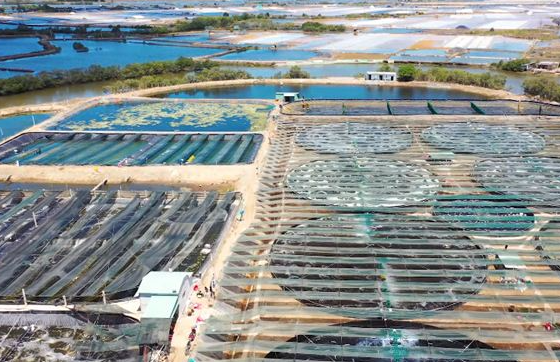(seafood.vasep.com.vn) Amid the growing challenges of climate change and increasingly stringent market demands, high-tech shrimp farming in Bac Lieu has emerged as a breakthrough solution, delivering economic efficiency, environmental sustainability, and enhanced value for Vietnam’s aquaculture sector.

For years, Bac Lieu has been known as Vietnam’s “shrimp capital,” with extensive farming areas and high production volumes—particularly for black tiger shrimp and whiteleg shrimp. However, to maintain and maximize this advantage in the face of globalization and climate change, transitioning to high-tech shrimp farming has become essential. This shift is not just a trend—it is the key for Bac Lieu to maintain its leadership and elevate Vietnam’s shrimp value chain on the global stage.
The Mekong Delta in general—and Bac Lieu in particular—is one of the regions most vulnerable to the impacts of climate change. Deep saltwater intrusion, droughts, erratic flooding, and rising shrimp diseases have created significant challenges for farmers. Traditional farming models such as extensive or semi-intensive systems are particularly susceptible to these factors, resulting in unstable productivity and high risk.
Global Standards Driving Innovation
International consumers, especially in major import markets like the US, the EU, and Japan, are placing increasing emphasis on the origin, quality, and sustainability of shrimp products. Certifications such as ASC (Aquaculture Stewardship Council), GlobalG.A.P, and BAP (Best Aquaculture Practices) present technical challenges—but also opportunities—to boost the value of Vietnamese shrimp. High-tech farming enables better control over inputs, farming processes, and antibiotic residues, making it easier to comply with strict international standards.
Recognizing the sector’s importance, the Vietnamese government and relevant ministries have introduced policies to encourage investment in high-tech shrimp farming. Since 2024, Bac Lieu has made notable progress in applying advanced technologies. According to provincial reports, the area under high-tech shrimp farming—including super-intensive, intensive, and semi-intensive models—reached approximately 32,987 hectares in 2024, fulfilling 112.2% of the year’s plan and marking a 113.14% increase compared to 2023. This growth reaffirms Bac Lieu’s commitment to leading the nation in high-tech aquaculture.
Supportive Policies and Smart Technologies
To achieve these results, Bac Lieu has proactively developed specific programs and initiatives, facilitating land access, credit, and technical support for businesses and farmers. The province has intensified investment promotion efforts for its High-Tech Agricultural Zone for Shrimp Development, attracting major investors.
High-tech farming models—such as super-intensive systems in greenhouses or lined ponds with roofing—have become increasingly popular. Key innovations include widespread adoption of recirculating aquaculture systems (RAS) or semi-recirculating systems.
Many large companies have invested in expanding or building new farming zones, applying automation in water supply, feeding, and environmental management. These models deliver exceptional yields—averaging 40–60 tons per hectare per crop, and in some cases reaching 80–100 tons—far surpassing traditional methods. Shrimp survival rates have also improved significantly, reducing the risk of disease.
Data-Driven Farming
Industry 4.0 technologies are being deployed directly at pond level. Sensors continuously monitor key water parameters such as dissolved oxygen, pH, salinity, temperature, alkalinity, and toxic gases (NH₃, H₂S). The data is transmitted to centralized control systems or smartphone apps, allowing farmers to monitor and adjust conditions in real time.
Bac Lieu’s high-tech shrimp farming model aims to meet global certifications like ASC, GlobalG.A.P, and BAP, thereby enhancing its reputation and competitiveness on international markets. Many enterprises have developed integrated value chains covering broodstock production, grow-out farming, processing, and marketing, ensuring traceability and strict quality control.
With better quality control and high yields, Bac Lieu shrimp has strong export growth potential, contributing significantly to both provincial and national GDP. In 2024, the province's shrimp export turnover showed promising signs, and further growth is projected for 2025 and beyond.
A Vision for the Future
Bac Lieu’s high-tech shrimp farming model is on a strong upward trajectory, becoming a key driver of Vietnam’s blue economy. With its achievements to date, the province is steadily asserting its pioneering role in building a modern and sustainable shrimp industry—contributing not only to food security and export growth but also to elevating the global presence of Vietnamese shrimp. Continued collaboration between the government, businesses, and farmers will be crucial for Bac Lieu to reach new heights and bring Vietnamese shrimp to the most demanding markets worldwide.